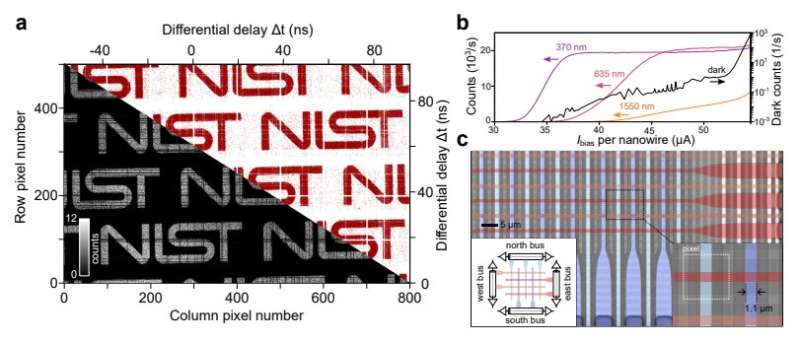July 5, 2023 report
This article has been reviewed according to Science X's editorial process and policies. Editors have highlighted the following attributes while ensuring the content's credibility:
fact-checked
preprint
trusted source
proofread
Superconducting nanowire camera will explore brain cells, space

Researchers have made a breakthrough in the development of a camera so sensitive it can detect a single photon.
A photon is a tiny particle composed of electromagnetic waves. It is the basic unit that makes up light, but it has no mass and no charge. Microwaves, infrared light and X-rays are all made up of photons.
The technology to capture individual photons was developed at a Moscow University two decades ago. But technical obstacles prevented its widespread use beyond research labs.
A team at the National Institute of Standards and Technology in Boulder, Colorado, has reported the successful implementation of a 400,000 pixel superconducting nanowire single-photon detector (SNSPD) that they say will pave the way for the development of extremely light-sensitive large-format superconducting cameras. Their paper, "A superconducting-nanowire single-photon camera with 400,000 pixels," was published in the preprint repository arXiv on June 15.
Researchers from the University of Colorado's Department of Physics and the Jet Propulsion Laboratory at the California Institute of Technology also participated in the project.
The camera is now the largest of its type. Its pixel array is 400 times greater than the previous largest photon camera. It can work in various light frequencies from the visible to ultraviolet and infrared range and capture images at super high-speed rates, in matters of picoseconds.
Such high-precision cameras can be used in quantum computing, communications and space exploration.
The challenge of photographing distant stars and planets was described in a 2020 report by researchers doing similar work in high-speed photographic tools. According to Sarah Steiger, a doctoral student working with noted researcher optical sensor expert Ben Mazin of the University of California, Santa Barbara, "In exoplanet direct imaging, you are attempting to image planets that are millions of times fainter than their parent stars. It's the equivalent of trying to see a firefly next to a fully lit football stadium from a plane."
"What's more, if you are doing this from the ground, you must look through Earth's turbulent atmosphere," she said.
The camera will also prove invaluable for those doing medical research, where the ability to examine organs such as the brain without disturbing tissue is critical.
"This nanowire technology is really well-suited for the light that's preferably used in bio-optical devices," said Roarke Horstmeyer, an assistant professor of Biomedical Engineering at Duke University,
To achieve such photographic precision and speed, the team had to overcome obstacles facing earlier efforts at high precision photography such as electrical noise, readout speed and environmental temperature.
"From a scientific perspective, this is definitely opening a new avenue in optical brain imaging," said Stefan Carp, an associate professor of radiology at the Harvard Medical School. "Other approaches for optically mapping cortical brain flow may have lower costs, but they all have shortcomings impacting signal quality that often require complex signal processing. There is no compromise with nanowires from a performance perspective."
More information: Bakhrom G. Oripov et al, A superconducting-nanowire single-photon camera with 400,000 pixels, arXiv (2023). DOI: 10.48550/arxiv.2306.09473
Journal information: arXiv
© 2023 Science X Network




















